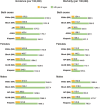Disparities in care of older adults of color with cancer: A narrative review
- PMID: 38234214
- PMCID: PMC10905558
- DOI: 10.1002/cam4.6790
Disparities in care of older adults of color with cancer: A narrative review
Abstract
This review describes the barriers and challenges faced by older adults of color with cancer and highlights methods to improve their overall care. In the next decade, cancer incidence rates are expected to increase in the United States for people aged ≥65 years. A large proportion will be older adults of color who often have worse outcomes than older White patients. Many issues contribute to racial disparities in older adults, including biological factors and social determinants of health (SDOH) related to healthcare access, socioeconomic concerns, systemic racism, mistrust, and the neighborhood where a person lives. These disparities are exacerbated by age-related challenges often experienced by older adults, such as decreased functional status, impaired cognition, high rates of comorbidities and polypharmacy, poor nutrition, and limited social support. Additionally, underrepresentation of both patients of color and older adults in cancer clinical research results in a lack of adequate data to guide the management of these patients. Use of geriatric assessments (GA) can aid providers in uncovering age-related concerns and personalizing interventions for older patients. Research demonstrates the ability of GA-directed care to result in fewer treatment-related toxicities and improved quality of life, thus supporting the routine incorporation of validated GA into these patients' care. GA can be enhanced by including evaluation of SDOH, which can help healthcare providers understand and address the needs of older adults of color with cancer who face disparities related to their age and race.
Keywords: geriatric assessment; geriatric oncology; healthcare disparities; minorities; older adults; oncology.
© 2023 The Authors. Cancer Medicine published by John Wiley & Sons Ltd.
Conflict of interest statement
Shannon M. Lynch has received fees as a consultant with Beautycounter. Efrat Dotan has received grants or contracts from Incyte, Ipsen, Lilly, MedImmune, NGM Biopharmaceuticals, Relay Therapeutics, Lutris, Kinate, and Zymeworks; she has received consulting fees from Incyte, Helsinn, G1 therapeutics, Taiho, Olympus, and Amgen; and payment or honoraria from Pfizer. Joanne C. Ryan is an employee and shareholder of Pfizer, which provided funding for editorial support for the manuscript and is acknowledged above. Edith P. Mitchell has received grants or contracts from Bristol Myers Squibb, Exelixis, Genentech, GlaxoSmithKline, Pfizer, and Regeneron; she has received consulting fees from Astellas, Bristol Myers Squibb, Corvus, Genentech, and Janssen.
Figures


References
-
- Smith BD, Smith GL, Hurria A, Hortobagyi GN, Buchholz TA. Future of cancer incidence in the United States: burdens upon an aging, changing nation. J Clin Oncol. 2009;27(17):2758‐2765. - PubMed
-
- American Association for Cancer Research . AACR Cancer disparities progress report. 2022. Accessed February 22, 2022 http://www.CancerDisparitiesProgressReport.org/ - PubMed
-
- National Cancer Institute . Cancer Disparities. 2022. Accessed February 22, 2022 https://www.cancer.gov/about‐cancer/understanding/disparities#contributi...
Publication types
MeSH terms
Grants and funding
LinkOut - more resources
Full Text Sources
Medical

